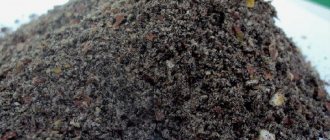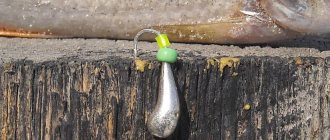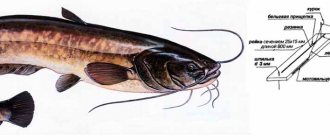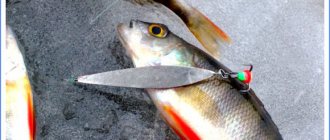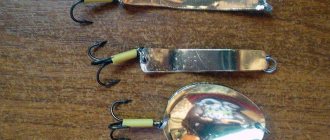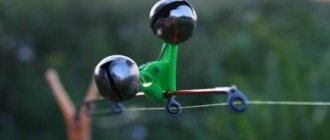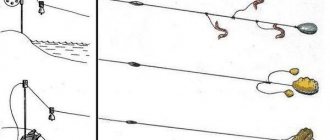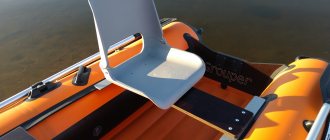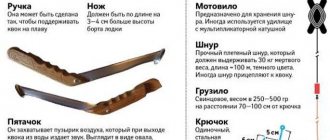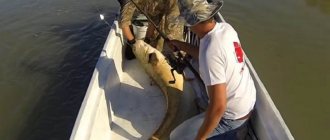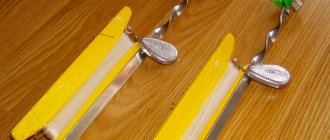Many fishermen want to catch big fish, and for this they need to use not ordinary, but some special gear. Kwok is one of these tools; it is extremely effective when hunting catfish; this tool has very ancient historical roots.
The fact is that the quok makes an unusual sound, the catfish hears it and begins to move in the direction from which it heard the sound. In fact, it is still unclear why the catfish follows this sound. Perhaps the reason for this is that when swallowing food, the catfish produces a similar sound.
Kwok can be obtained in two ways: buy ready-made, or make it yourself. Most fishermen prefer to make the kwok themselves, because in this case they make the tool specifically for themselves, customizing it to their needs.
Kwok design
If you decide to make a quok yourself, know that its design includes the following parts:
- Pen;
- Knife;
- Piglet.
Each part has its own function and therefore, if you decide to make a quok yourself, then these parts will have to meet certain criteria:
- The handle should be adjusted to you so that it is comfortable for you to hold it. Make it from a material that will allow you to hold it well in your hand, even if it is wet, so that it does not slip out of your hands. As a rule, it is made of wood.
- The knife should be thin enough so as not to cause strong water resistance. As a rule, it is most often made of steel, aluminum or wood.
- The patch is best made of metal. Try to make its surface as smooth as possible, this will significantly improve the sound quality.
How to make a drawing
The drawing is not so difficult to draw; even someone who is completely unfamiliar with this device can do it. When making a drawing, pay attention to the following points:
- Decide what shape you want your instrument to have;
- The second aspect is the width of the handle. As a rule, about 30 mm, but you can make it narrower or wider, as is more convenient for you;
- A Kwoka knife is usually made with a bend; the length of the handle before the bend should be about 12 cm;
- Its length should not be more than 22 cm;
- Make sure that there is an angle between the handle and the cutwater (knife) in the range of 35-40 degrees;
- The knife should gradually taper from handle to tip from 25 mm to 20 mm;
- The heel width is also about 25 mm.
Select form
If you want to make a catfish quok with your own hands, it is worth considering the options for its design, the main 4:
- Atanovsky Kwok. Due to the simplicity of its manufacture, it is the most common. His knife is straight, the kind that can easily be made from metal, and the penny has a rectangular shape with rounded edges. The handle is usually made of wood.
- Kyiv Kwok. The difference between it and the previous one is that its knife has a curved shape, which has no corners, but smoothly transitions into the handle. It is worth noting that it will be much more difficult for you to make such a quok, and you will also need more raw materials.
- The Severodonetsk kwok is generally similar to the Kyiv one, but its knife is more steeply curved. It also features a striker that is oval in shape.
- Hungarian Kwok. It looks very fancy and resembles a sickle in shape. The blade smoothly transitions into the handle and has 2 smooth bends.
If you are planning to perform the catfish quok for the first time with your own hands, know that the most suitable design in this situation will be the Atanov one due to the fact that it is the simplest and quite universal.
What does kwok consist of?
Kwok consists of three main parts :
- handles;
- knife;
- Piglet.
Each of these parts must be manufactured so that it can best perform its function.
The handle should be comfortable, therefore, it should be made of a pleasant-to-touch material that will not slip in the hand . In addition, if the kwok is not made of wood, the handle should be made of light material to ensure its buoyancy - after all, when biting a trophy, the firecracker can easily be dropped from your hands, and it will be very disappointing to lose a catchy kwok made with your own hands.
The knife , located between the handle and the coin, should not interfere with the formation of bubbles during quoting, the rupture of which causes gurgling sounds attractive to catfish. The thinner it is, the better , in this case it will be as easy as possible for the fisherman to croak, producing the sound of the desired boominess and sonority.
The purpose of the snout is to capture a little air with each blow of the quok on the water and drag the resulting bubble under the surface. It should have as sharp edges as possible , while the patch can be either concave or flat.
Materials for making kwok
Once you have decided on the shape, choose the materials you will use to make the kwok. The material varies depending on the part of the quok.
A nickel can be made from:
- Metal;
- Epoxy resin;
- Tree.
The water cutter can be made from:
- Metal;
- Plastic;
- Plexiglas;
- Tree.
When making a handle you can use:
- Wood (the most common option);
- Neoprene;
- Styrofoam.
Rod equipment
Feeder rods are divided into three types:
The length of the rod should depend on the depth of the reservoir. For fishing from the shore, as a rule, a feeder of up to 4 meters is selected. When catching medium-sized catfish, use a medium-action rod; to catch large and trophy species, you need a fast-action rod, otherwise you will likely end up with a broken rod.
In addition, when fishing with kwok, the fisherman must have a line and bait.
The tackle consists of the following components:
Since fishing for kwok takes place in a boat, the best option would be to help a friend when catching catfish. Fishing rods are placed along the sides of the boat and the bait is lowered into the water to half the level of the reservoir. When one is working with the hook, the other must have time to hook the fish that will grab the line.
Metal quoks
Even if we take into account that a large number of “kvochatniks” prefer wood as a material, the best tools are still those whose cutter and nickel are made of metal.
Kwok made of metal has a number of advantages:
- Easier to use: for high-quality sound, the cutwater should be thin enough to cut through the water. Metal quoks are much more acceptable, because the knife can be made quite thin, and the coin can be given sharp edges, making it easier to achieve the desired sound.
- Easy to make: of course, a metal kwok is much easier to make; you just need to find a suitable knife and attach a handle and a coin to it. In the case of wood, everything will be much more complicated.
- Reliability: if you make a metal quok correctly, it will be reliable and durable, and will not have any limitations on its service life.
At the same time, a metal quok has a number of disadvantages:
- It has a less natural and less pleasant sound to the ear than a wooden kwok.
- If you let him fall into the water, he will drown.
Advice: if you decide to make a metal quok, it is best to make the handle from a material that will maximize the buoyancy of the tool. This can be wood, foam plastic, neoprene, and other materials that will give the quok positive buoyancy. Please note that the lighter it is, the higher its buoyancy will be. For example, if you make a handle from neoprene, then even if the penny and cutwater are metal, it will not sink.
Availability of drawings
To figure out how to make a quok with your own hands, you need to carefully study the step-by-step instructions, dimensions and electronic drawings of a quok for catching catfish. By the way, the latter are easy to draw yourself. The main thing is to take into account the main points and characteristic features . Among them the following points should be highlighted:
- Initially, you need to choose the appropriate shape of the future tool, and also determine the size of the handle, taking into account the physical characteristics of the fisherman, namely the width of the palm.
- The knife of the product is created with a certain bend, the distance to which is about 12 centimeters. The total length of this element is 22 centimeters.
- At the manufacturing stage, you need to maintain an angle between the handle and the knife in the range of 35-40 degrees.
- The knife should taper smoothly from the handle to the penny, and the width of the penny can be in the range of 25-30 mm.
If you follow these recommendations, further production of the product will not be difficult.
Wooden quok
If we talk about wooden quokkas, it is certainly impossible not to notice that they look very natural and aesthetically pleasing. Especially when they are made from one piece of wood.
But, unfortunately, they are short-lived and are not as easy to use as metal ones. In addition, it is much more difficult to produce the necessary sound with their help, and when using them you will get tired faster.
Please note that making this instrument from one whole piece of wood is a very difficult task.
Hooking and landing catfish
After hooking the catfish, you need to “release it”. To do this, the quok is released from the hand, and the left hand with the cord is raised. The catfish pulls, the cord unwinds from the reel. Then the cord is taken into the right hand - the actual fishing begins, during which the tension of the cord is regulated by one’s own efforts, and its slack, which is formed when the direction of movement of the catfish changes, is selected. If the force with which the catfish pulls is constant, then the cord can not be released, and then the catfish will tow the boat. After he gets tired, he needs to be pulled out, preferably to a sandbank chosen in advance. When the catfish is pulled aground, it should be grabbed with your hands under the pectoral fins and dragged away from the water.
Catfish can be caught using quok at any time of the day - morning, afternoon, evening. Once, out of curiosity, I tried fishing at night. Som took it. But I don’t fish at night anymore: it’s dark, it’s uncomfortable, and there’s no need, since he takes it in the light. There is an opinion that the best time to bite catfish is early morning and before sunset. But there are times when neither morning nor evening fishing brings success, but during the day the catfish bites actively.
I can’t say anything about the influence of weather on the bite of these predators - I didn’t find any patterns. I had to pull out catfish in bright sunshine, in cloudy weather, in calm weather, and in windy conditions. Generally speaking, statistics when catching catfish is a difficult matter, since often catching just one catfish means the end of fishing.
Author: G. Atanov, almanac “Fisherman-Sportsman”, No. 50, 1990
How to make a kwok with your own hands
Considering the fact that the Atanovo quok is easier to make than others, and the fact that its shape does not reduce its sound quality, it is an excellent choice for the first quok you make.
To begin, make blanks from the materials you will use:
- A metal sheet 2-2.5 mm thick from which the knife will be made. A duralumin sheet is ideal;
- Metal 3-5mm thick for the patch. You can use aluminum for this;
- Wooden plank 20x30 mm. You can choose the tree to your taste, for example it could be oak.
Then proceed directly to the process of making kwok:
- First of all, you will need to make a knife. To do this, cut a blank from a sheet of metal up to 30 cm long and 2.5 cm wide at the top and 2 cm at the bottom. Use the tools available to you for this, such as a jigsaw or grinder.
- Measure from the lower end the future length of the blade no more than 220 mm. After this, clamp it in a vice and sharpen the lower edge so that the surface that will come into contact with the water is sharper than the upper part.
- After the previous steps, it will be necessary to sand the knife to remove any existing roughness and irregularities. A file or sandpaper is suitable for this.
- Next, start making the handle. Make a workpiece with dimensions 150x35x25 mm. Using a protractor, mark the angle at which the handle will connect to the blade. It should be within 35 - 40 degrees. After this, make a cut for the knife seat.
- Soften the angle where the handle meets the knife, adjusting the handle so that it fits well in your hand.
- After this, carve a finger at the bottom of the knife that will fit into the penny.
- Start making a blank for a nickel with dimensions of 45×25 mm. You will need to cut a groove in it that matches the finger on the knife. In addition, you will need to make a secret hole - this is a special hole in which the blade will fit. The potay is made so that the junction of the knife and the nickel is stronger.
- After this, the corners of the workpiece must be rounded so that the penny has an ellipsoidal shape and sharp edges.
- The final stage will be combining all the parts together. You can glue the knife and handle using epoxy resin, and in order to firmly connect the blade and the nickel, you need to insert your finger into the cutout, and it should protrude 1 mm above the working surface of the nickel, then rivet it.
Manufacturing
We will describe the production of kwok for the “Atanovsky” version. We made our choice consciously, since thanks to the clarity of the forms, the drawing and the exact dimensions of the elements, it is difficult to make a mistake when working on it.
Having made a catfish tool of this design and tested it in practical fishing, it will be possible to proceed to other models.
All work on creating a quok is divided into several stages.
- Making a knife.
- Making a handle and connecting it to a knife.
- Cutting out a tenon.
- Preparing a nickel.
- Final assembly of the product.
Materials
To make the “Atanovsky” quok we will need:
- 2 mm thick duralumin for the knife;
- 20 mm thick aluminum for the handle;
- aluminum 3-5 millimeters thick for the patch;
- wooden strip, preferably oak or ash, for the handle;
- sheet cork for finishing;
- rivets for connecting parts or a piece of thick aluminum wire;
- acrylic lacquer;
- glue.
Making a knife
We start making kwok with our own hands from a knife, since this element ties all the details of the structure together.
- We cut a strip 300 millimeters long from a piece of duralumin. The upper part should have a width of 25 millimeters, the bottom – 20. For work, we use an electric jigsaw or a hacksaw for metal.
Marking and cutting out a knife
- Having clamped the strip in the ticks, having previously placed spacers between the workpiece and the cheeks, we process it with a bastard file. In this way, we not only smooth out burrs, but also give the future knife the desired size.
- We measure 230 millimeters from the narrow side of the knife.
- We clamp the wide part of the workpiece in a vice, placing the measured end outward.
- Using files, we process the knife so that its cross-section has the shape of a narrow sheet: flat at the front, steep at the back.
- Having given the desired shape, we perform the final grinding of the blade with various sandpapers, ending with “zero”.
Making the handle
Without putting the knife far away, we begin to form the handle. We do it in the following sequence:
- We cut a piece of thick aluminum 150 millimeters long and 30 wide.
- We apply the knife from below at an angle of 40 degrees, mark the line with a pencil.
- Clamping the workpiece in a vice, we make a cut to the specified line. The width of the cut should correspond to the thickness of the knife; this can be easily achieved by putting together several hacksaw blades for metal.
- Insert the knife into the workpiece.
- After checking the angle, drill two holes for the rivets.
- We insert temporary rivets.
- We saw off the excess parts from the handle and knife.
- We take out the rivets and grind the handle blank.
- We cut out handle linings from wooden planks or thick foam.
- We insert the knife into the handle using epoxy glue.
- We insert rivets and finally rivet the parts.
Carving a tenon
After the handle and knife are connected, we need to cut a spike at the bottom of the blade.
- Using a simple thin pencil, draw a line at the bottom of the blade, which will make a right angle with the imaginary axis of the handle.
- We mark the tenon cutting pattern. It should be at right angles to the resulting mark in the center of the knife. Its width is 7-8 millimeters, and its length is one millimeter greater than the thickness of the patch.
- We cut out and process the tenon.
Preparing the patch
The piglet is made of aluminum 3-5 millimeters thick, the difference is insignificant and practically does not affect the operation of the quok.
- We cut out a blank measuring 25x45 millimeters.
- We saw through the groove along the edges to half the thickness, right through in the center. This is done in such a way that a spike is inserted into the through hole, and a knife into the secret hole.
- We process the patch to give it an elliptical shape. The bottom should be flat and the edges should taper towards the top.
The shape of the patch may be different; the attachment point with the knife is important here.
Final assembly
For final assembly, all that remains is to rivet the patch to the knife. This is done like this:
- We clamp the knife in a vice.
- From the working part of the patch at the place of the cut, we remove the chamfer with a sharp, durable knife.
- We put a snout on the knife. The strip of metal protruding outward should not exceed one millimeter; if necessary, grind off the excess.
- Using a hammer and drift, we rivet the protruding tenon.
- We glue the cut out pads onto the handle.
- We grind and polish the product.
- The handle is coated with acrylic varnish.
Our homemade quok is ready. With it you can already go to the river to catch the owner of the river - catfish.
Technique for catching catfish using kwok
It is best to act in pairs, since it will be very difficult to cope with the catch alone, especially if it is large enough. In order to catch catfish using a quok, you will need high-strength bottom gear with strong hooks, as well as a heavy sinker and a boat.
You need to sail to the place where you think catfish is introduced. As a rule, catfish are found in the pit. You can find it by visible splashes at depth. After this, you can set up the bottom tackle and start “nodding”.
Nodding and why it attracts catfish
The striking part should be immersed no more than 10 centimeters.
In this case, the trajectory of the quok's movement should resemble an arc, so that the moment the hoof emerges from the water, a sound arises, a little like the sound of a bottle of wine being uncorked. These sounds are quite effective at attracting catfish. The exact reason for this is not known, but the most plausible options are:
- When a catfish swallows prey on the surface, it produces a similar sound. Hearing the sound, the catfish hopes to profit from the prey;
- The sound of a quok is similar to the sound of a female catfish calling.
How do you catch catfish with a quok?
- In order to increase efficiency, you should hit the water with the kwok several times, then wait a little and then repeat;
- When the catfish swims up, you need to wait until it swallows the bait as deeply as possible;
- After this you will need to pull hard and sharply. When the catfish is on your hook, you will spend several minutes fighting it.
- When the catfish gets tired, pull it out of the water;
- Stun him after he is in the boat so that he does not start to fight, thereby rocking the boat;
- During fishing, one fisherman takes control of the boat and periodically hits the water with a quok, while the other throws in the gear and takes out the catch.
How to choose a place and time for fishing
The most common places for catching catfish are pits and the waters near them. You can find such places in the waters of rivers and lakes using an echo sounder and a navigator. Catfish can often be found at sharp turns of rivers, the banks of which are steep and steep, in waters with rich vegetation.
You can choose any time, but July-August is best. As for the time of day, it is best caught between dusk and dawn. Although, using kwok, you can catch it during the day.
Kwok fishing gear
Considering the fact that you will be fishing from a boat, you will need suitable equipment.
- For this, a strong fishing line is suitable that can withstand 100 kg; you can wind it both on a reel and on a reel;
- If you want to use a rod, it should be stiff and short and have guides;
- At the end of the fishing line, attach a leash one meter long, 0.5-0.8 mm thick;
- Attach a powerful hook to it, no smaller than No. 30;
- Select the sinker according to the depth and bait.
Lures and Lures
If you decide to catch catfish, then the following bait options are suitable for you:
- Bunch of worms;
- Perch;
- Frog;
- Cancer;
- Bark beetle larvae;
- Locust and mole cricket;
- Pieces of fish and meat;
- Scorched bird;
Catfish tackle and fishing tactics
When assembled, the tackle consists of the following. A nylon cord 30-50 meters long and 3-4 millimeters in diameter is wound on a reel in a figure eight. This method of winding all kinds of fishing lines is the most convenient in general, but it is rare to see it used even by experienced fishermen. Its main advantage is that the line does not twist. If you wind the fishing line in the usual way, then with each revolution around the reel it twists one revolution around its axis. With a figure eight, the winding is done half a turn in one direction and half a turn in the other direction, and the line does not twist. In addition, it is very easy and simple to unwind from the reel.
A sinker weighing 150-200 grams is attached to the free end of the cord. The easiest way to do this is as follows: tie a loop at the end of the cord, and then wrap the knot with a strip of sheet lead about 50 millimeters wide so that the end of the loop remains outside. The leash is attached to this loop. It can be from a vein with a diameter of 0.9-1 millimeter (I caught the largest catfish weighing 86 kilograms using tackle with a 0.9 leash). But it is better to use a nylon cord, since, as already mentioned, catfish have many small and sharp teeth that sometimes scratch the vein. The length of the leash is 50-60 centimeters.
You need a big hook. If the catfish weighs 30-35 kilograms, then a hook number 25-30 is sufficient. I usually fished with hook No. 36, but last year I ran out of these hooks and had to use No. 30. As a result, there were several gatherings of very large catfish. So I switched to No. 40.
Large hooks are extremely rarely on sale, and you have to make them yourself from spring wire with a diameter of 3-4 millimeters. The hook, with the exception of the sting, must be hardened.
I don't use any rods or reels. I tie the cord to the quok at a distance of 4-5 meters from the hook, for which I make a hole in the handle of the quok. The entire supply of cord is on the reel.
As already mentioned, catching catfish using kwok is done from a boat. The best is a kayak: it is light, and a large catfish drags it without much effort, so you don’t have to worry about the integrity of the gear. The kayak is very easy to use and does not require much effort from the rower. True, the standard Taimen kayak is a bit narrow; in this sense, it is superior to the previously produced Salyut. My kayak is specially expanded. As a result, its performance decreased somewhat, but its stability increased significantly.
It is most convenient to fish together. Firstly, it’s practically impossible to pull out a large catfish alone. And secondly, you need an assistant who would keep the boat on course, preventing it from deviating under the influence of wind or current.
Anything that catfish feed on is suitable as bait, but delicacies are still preferable - cabbage worms, large caterpillars, May beetle larvae, leeches, large grasshoppers. I consider locusts to be the best bait; I mainly fish with them, putting two on the hook.
How to choose a good quok if you decide to buy it
First of all, decide on the material you want. It's better to choose one that won't sink. The best option would be to combine metal with wood or plastic.
- It is best to choose an oval nickel;
- You should not take a kwok with a large nickel, as it will be difficult to work with if this is your first instrument. However, it is worth noting that the sound of this will be more believable;
- The handle should fit well in the hand;
- The working part must be perfectly polished.
In conclusion, it should be noted that careful selection of the place where you are going to catch catfish is very important. Make sure your gear is ready to take on big game. Learn to "croak" correctly and be careful not to hook too early. Gradually you will learn various nuances that can only be learned through practice.
Features of catching catfish using kwok
Now you need to choose the right place to catch catfish. As a rule, catfish live in pits and areas adjacent to pits. To find such places in the water, use an echo sounder or navigators. Catfish can also live in places such as:
- a sharp river turn with steep steep banks;
- whirlpool;
- exit to the oxbow lake;
- spill with abundant vegetation.
Successful catching of catfish using kwok depends on many factors. This includes the correct use of it, the correct presentation of the bait, the correctly selected fishing location, and even the correctly selected tackle.
You should also competently learn the technique of quoting and take your time when hooking when biting, and your catch of catfish using a quok will be successful.
A kwok made from wood with your own hands allows you to catch quite large fish. Basically, its sounds attract catfish. Small fish may also swim to shore after hearing such a sound. The catfish rises from the river bottom and swims to the bait.
But if the sounds are incorrect, the fish will not bite the bait. At first she will simply wait, on guard, and then swim away. They refuse to respond to inappropriate soma sounds. If nooking occurs incorrectly, the prey may become frightened and sink to the bottom. Therefore, you need not only to make a decoy with your own hands, but also to learn how to use it correctly.
Catching catfish at different times of the year
Catching catfish in spring
With the onset of spring, this predator tries not to leave its wintering place.
And when the water temperature warms up in April, it begins its vigorous activity. Moving through shallow water, he looks for places to bask in the sun. The most successful places for catching catfish are the edges and coastal areas of the reservoir. The fish tries to find cleaner water for itself. And when the water temperature becomes a little more than 10 degrees Celsius, the catfish begins to disperse throughout the reservoir.
You should catch catfish using quok early in the morning at this time of year. After winter hibernation in the pits, when the water has warmed up to 8-10 degrees Celsius, the catfish begins its activity.
The bite usually begins depending on the weather: the beginning or end of April. The fish tries not to leave its wintering place, swimming only to shallows and reaches.
When temperatures warm up to 12 degrees Celsius or higher, catfish activity resumes. According to experts in this area, the best time to catch fish is in the morning, but their activity decreases at night.
With the onset of spawning, the catfish becomes hungry, and the bite increases accordingly. The spawning itself lasts about three weeks.
April is the most suitable month for catching catfish in the spring . However, sudden changes in weather can adversely affect the catch.
Fishing in the spring with quok is carried out in two ways:
This predator should be fed with insects such as:
Shellfish and live bait (frog, crustaceans) are also suitable.
Catching catfish in summer
As a rule, catching catfish in summer does not promise the capture of large specimens.
After spring spawning, the catfish enters a period of main feeding, and already at night it begins to hunt for insects and small fish. In the morning and daytime, the catfish prefers to sit out in pools or in the shade where tree branches hang. But with the onset of night, the river begins to splash, where the fish come out to hunt. During the hot months of the year, there is a lot of food in the reservoir for catfish, which it loves. There you can find:
When the weather is calm, the best months of summer are July and August. During the morning and day, the fish manages to get enough, and in the late afternoon it appears on the surface again to hunt waterfowl.
In the evening, catfish look for small fish at shallow depths, and an angler who decides to try his luck in catching this predator should not miss his chance to catch such a trophy.
Experienced fishermen have noticed that in summer catfish actively bite during thunderstorms.
You should look for catfish where there is a lot of aquatic vegetation and near holes. This is where this large predator lurks. You can also look for the habitat of catfish in peat holes.
Kwok device
The design of the beater is simple, but at the same time extremely functional. It consists of three parts :
- handles;
- a knife, also called a water cutter;
- snout, or hoof.
The only requirement for the handle is that it fits comfortably in the palm of your hand . Ideally, it should be made individually for each angler.
The piglet can be called the most important element of the kwok, because it is it that is responsible for creating the correct sound. When hitting the water, this part of the beater captures an air bubble from the surface and carries it down. When it bursts, it makes that deep pop that attracts catfish.
The piglet has an oval shape; in its central part there is a depression, thanks to which it captures and holds the air bubble. The thinner the snout, that is, the smaller its height, and the sharper its edges, the easier it is to cluck with it, producing the necessary sounds with each impact on the water.
The knife connects the handle and the snout. It can be curved or straight. In a classically designed kwok, the knife has a bend of about 40 degrees. In order to get the “bulks” needed to attract fish with minimal effort, it is better to use quoks, which cut through the water as easily as possible.
Choosing a fishing spot
Any fisherman will be happy if he sees where the fish are swimming. That's why they came up with such a device as an echo sounder. With its help you can easily choose a place for future fishing.
The main functions of the echo sounder are:
You can use the echo sounder in two ways:
The echo sounder beam scans the depth of the reservoir and transmits the image to the screen. But this device will only show where the catfish may be located approximately. Even the most powerful sonar will not provide a clear picture of the fish’s habitat.
When the place has been chosen, the bottom and prey have been determined, you can work with the quok, attracting fish with its characteristic sound. Then it's a matter of practice.
What to use to catch catfish?
To catch catfish, you need to prepare your bait with what it likes. For this we collect:
It happens that predator baits are divided into several categories:
Artificial baits. They are sold in fishing stores. They look like worms, mice, amphibians, etc. And even if there is some ready-made live bait, the catfish will still take the artificial bait with it.
Live bait. To do this, they use small fried animals that the catfish can swallow. These include:
You can also prepare the bait yourself:
Catfish baits, video:
